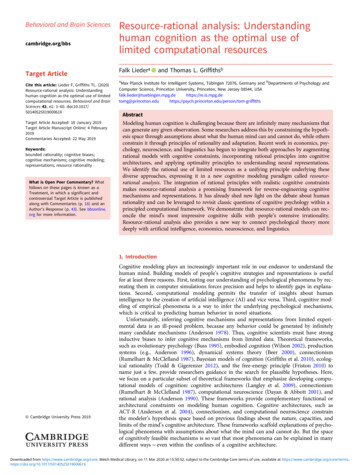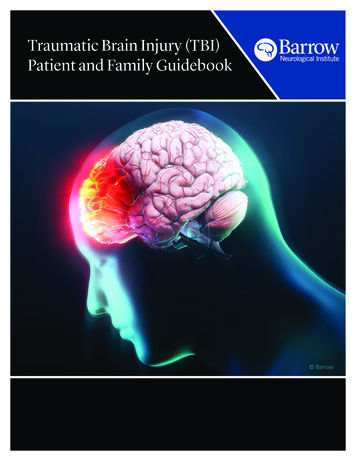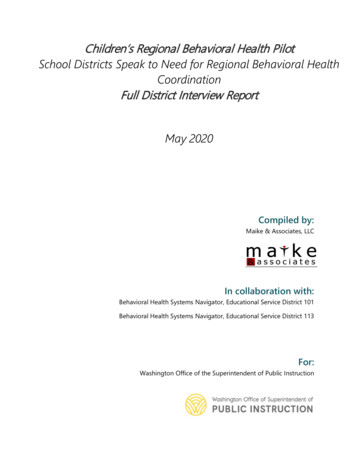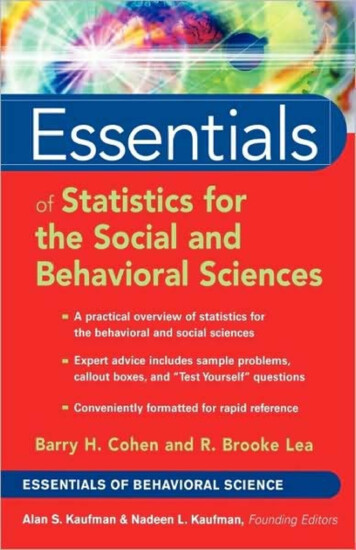
Transcription
Behavioral and Brain Sciencescambridge.org/bbsTarget ArticleCite this article: Lieder F, Griffiths TL. (2020)Resource-rational analysis: Understandinghuman cognition as the optimal use of limitedcomputational resources. Behavioral and BrainSciences 43, e1: 1–60. doi:10.1017/S0140525X1900061XTarget Article Accepted: 18 January 2019Target Article Manuscript Online: 4 February2019Commentaries Accepted: 22 May 2019Keywords:bounded rationality; cognitive biases;cognitive mechanisms; cognitive modeling;representations; resource rationalityWhat is Open Peer Commentary? Whatfollows on these pages is known as aTreatment, in which a significant andcontroversial Target Article is publishedalong with Commentaries (p. 16) and anAuthor’s Response (p. 43). See bbsonline.org for more information.Resource-rational analysis: Understandinghuman cognition as the optimal use oflimited computational resourcesFalk Liederaand Thomas L. GriffithsbaMax Planck Institute for Intelligent Systems, Tübingen 72076, Germany and bDepartments of Psychology andComputer Science, Princeton University, Princeton, New Jersey 08544, son/tom-griffithsAbstractModeling human cognition is challenging because there are infinitely many mechanisms thatcan generate any given observation. Some researchers address this by constraining the hypothesis space through assumptions about what the human mind can and cannot do, while othersconstrain it through principles of rationality and adaptation. Recent work in economics, psychology, neuroscience, and linguistics has begun to integrate both approaches by augmentingrational models with cognitive constraints, incorporating rational principles into cognitivearchitectures, and applying optimality principles to understanding neural representations.We identify the rational use of limited resources as a unifying principle underlying thesediverse approaches, expressing it in a new cognitive modeling paradigm called resourcerational analysis. The integration of rational principles with realistic cognitive constraintsmakes resource-rational analysis a promising framework for reverse-engineering cognitivemechanisms and representations. It has already shed new light on the debate about humanrationality and can be leveraged to revisit classic questions of cognitive psychology within aprincipled computational framework. We demonstrate that resource-rational models can reconcile the mind’s most impressive cognitive skills with people’s ostensive irrationality.Resource-rational analysis also provides a new way to connect psychological theory moredeeply with artificial intelligence, economics, neuroscience, and linguistics.1. Introduction Cambridge University Press 2019Cognitive modeling plays an increasingly important role in our endeavor to understand thehuman mind. Building models of people’s cognitive strategies and representations is usefulfor at least three reasons. First, testing our understanding of psychological phenomena by recreating them in computer simulations forces precision and helps to identify gaps in explanations. Second, computational modeling permits the transfer of insights about humanintelligence to the creation of artificial intelligence (AI) and vice versa. Third, cognitive modeling of empirical phenomena is a way to infer the underlying psychological mechanisms,which is critical to predicting human behavior in novel situations.Unfortunately, inferring cognitive mechanisms and representations from limited experimental data is an ill-posed problem, because any behavior could be generated by infinitelymany candidate mechanisms (Anderson 1978). Thus, cognitive scientists must have stronginductive biases to infer cognitive mechanisms from limited data. Theoretical frameworks,such as evolutionary psychology (Buss 1995), embodied cognition (Wilson 2002), productionsystems (e.g., Anderson 1996), dynamical systems theory (Beer 2000), connectionism(Rumelhart & McClelland 1987), Bayesian models of cognition (Griffiths et al. 2010), ecological rationality (Todd & Gigerenzer 2012), and the free-energy principle (Friston 2010) toname just a few, provide researchers guidance in the search for plausible hypotheses. Here,we focus on a particular subset of theoretical frameworks that emphasize developing computational models of cognition: cognitive architectures (Langley et al. 2009), connectionism(Rumelhart & McClelland 1987), computational neuroscience (Dayan & Abbott 2001), andrational analysis (Anderson 1990). These frameworks provide complementary functional orarchitectural constraints on modeling human cognition. Cognitive architectures, such asACT-R (Anderson et al. 2004), connectionism, and computational neuroscience constrainthe modeler’s hypothesis space based on previous findings about the nature, capacities, andlimits of the mind’s cognitive architecture. These frameworks scaffold explanations of psychological phenomena with assumptions about what the mind can and cannot do. But the spaceof cognitively feasible mechanisms is so vast that most phenomena can be explained in manydifferent ways even within the confines of a cognitive architecture.Downloaded from https://www.cambridge.org/core. Welch Medical Library, on 11 Mar 2020 at 15:50:52, subject to the Cambridge Core terms of use, available at rg/10.1017/S0140525X1900061X
2Lieder and Griffiths: Resource-rational analysisAs psychologists, we are trying to understand a system farmore intelligent than anything we have ever created ourselves; itis possible that the ingenious design and sophistication of themind’s cognitive mechanisms are beyond our creative imagination. To address this challenge, rational models of cognitiondraw inspiration from the best examples of intelligent systemsin computer science and statistics. Perhaps the most influentialframework for developing rational models of cognition is rationalanalysis (Anderson 1990). In contrast to traditional cognitive psychology, rational analysis capitalizes on the functional constraintsimposed by goals and the structures of the environment ratherthan the structural constraints imposed by cognitive architectures.Its inductive bias toward rational explanations is often rooted inthe assumption that evolution and learning have optimallyadapted the human mind to the structure of its environment(Anderson 1990). This assumption is supported by empiricalfindings that under naturalistic conditions people achieve nearoptimal performance in perception (Knill & Pouget 2004; Knill& Richards 1996; Körding & Wolpert 2004), statistical learning(Fiser et al. 2010), and motor control (Todorov 2004; Wolpert& Ghahramani 2000), as well as inductive learning and reasoning(Griffiths & Tenenbaum 2006; 2009). Valid rational modelingprovides solid theoretical justifications and enables researchersto translate assumptions about people’s goals and the structureof the environment into substantive, detailed, and often surprisingly accurate predictions about human behavior under a widerange of circumstances.That said, the inductive bias of rational theories can be insufficient to identify the correct explanation and sometimes pointsmodelers in the wrong direction. Canonical rational theories ofhuman behavior have several fundamental problems. First,human judgment and decision-making systematically violate theaxioms of rational modeling frameworks such as expected utilitytheory (Kahneman & Tversky 1979), logic (Wason 1968), andprobability theory (Tversky & Kahneman 1973; 1974).Furthermore, standard rational models define optimal behaviorwithout specifying the underlying cognitive and neural mechanisms that psychologists and neuroscientists seek to understand.Rational models of cognition are expressed at what Marr (1982)termed the “computational level,” identifying the abstract computational problems that human minds must solve and their idealsolutions. In contrast, psychological theories have traditionallybeen expressed at Marr’s “algorithmic level,” focusing on representations and the algorithms by which they are transformed.This suggests that relying either cognitive architectures orrationality alone might be insufficient to uncover the cognitivemechanisms that give rise to human intelligence. The strengthsand weaknesses of these two approaches are complementary each offers exactly what the other is missing. The inductive constraints of modeling human cognition in terms of cognitive architectures were, at least to some extent, built from the ground up bystudying and measuring the mind’s elementary operations. Incontrast, the inductive constraints of rational modeling arederived from top-down considerations of the requirements ofintelligent action. We believe that the architectural constraintsof bottom-up approaches to cognitive modeling should be integrated with the functional constraints of rational analysis.The integration of (bottom-up) cognitive constraints and (topdown) rational principles is an approach that is starting to be usedacross several disciplines, and initial results suggest that combining the strengths of these approaches results in more powerfulmodels that can account for a wider range of cognitive phenomena. Economists have developed mathematical models ofbounded-rational decision-making to accommodate people’s violations of classic notions of rationality (e.g., Dickhaut et al. 2009;Gabaix et al. 2006; Simon 1956; C. A. Sims 2003). Neuroscientistsare learning how the brain represents the world as a trade-offbetween accuracy and metabolic cost (e.g., Levy & Baxter 2002;Niven & Laughlin 2008; Sterling & Laughlin 2015). Linguistsare explaining language as a system for efficient communication(e.g., Hawkins 2004; Kemp & Regier 2012; Regier et al. 2007;Zaslavsky et al. 2018; Zipf 1949), and more recently, psychologistshave also begun to incorporate cognitive constraints into rationalmodels (e.g., Griffiths et al. 2015).In this article, we identify the rational use of limited resourcesas a common theme connecting these developments and providing a unifying framework for explaining the corresponding phenomena. We review recent multidisciplinary progress inintegrating rational models with cognitive constraints and outlinefuture directions and opportunities. We start by reviewing the historical role of classic notions of rationality in explaining humanbehavior and some cognitive biases that have challenged thisrole. We present our integrative modeling paradigm, resourcerationality, as a solution to the problems faced by previousapproaches, illustrating how its central idea can reconcile rationalprinciples with numerous cognitive biases. We then outline howfuture work might leverage resource-rational analysis to answerclassic questions of cognitive psychology, revisit the debateabout human rationality, and build bridges from cognitivemodeling to computational neuroscience and AI.2. A brief history of rationalityFALK LIEDER leads the Max Planck Research Group for RationalityEnhancement at the MPI for Intelligent Systems in Tübingen. His current research builds on the theory of resource-rationality to develop ascientific foundation and practical tools for improving the humanmind by promoting and supporting cognitive growth, goal setting,and goal achievement.THOMAS L. GRIFFITHS is the Henry R. Luce Professor of InformationTechnology, Consciousness, and Culture at Princeton University. Hisresearch explores connections between psychology and computer science, using ideas from machine learning and artificial intelligence tounderstand how people solve the challenging computational problemsthey encounter in everyday life.Notions of rationality have a long history and have been influential across multiple scientific disciplines, including philosophy(Harman 2013; Mill 1882), economics (Friedman & Savage1948; 1952), psychology (Braine 1978; Chater et al. 2006;Griffiths et al. 2010; Newell et al. 1958; Oaksford & Chater2007), neuroscience (Knill & Pouget 2004), sociology(Hedström & Stern 2008), linguistics (Frank & Goodman 2012),and political science (Lohmann 2008). Most rational models ofthe human mind are premised on the classic notion of rationality(Sosis & Bishop 2014), according to which people act to maximizetheir expected utility, reason based on the laws of logic, and handle uncertainty according to probability theory. For instance,rational actor models (Friedman & Savage 1948; 1952) predictDownloaded from https://www.cambridge.org/core. Welch Medical Library, on 11 Mar 2020 at 15:50:52, subject to the Cambridge Core terms of use, available at rg/10.1017/S0140525X1900061X
Lieder and Griffiths: Resource-rational analysis3that decision-makers select the action aw that maximizes theirexpected utility (Von Neumann & Morgenstern 1944), that is aw arg maxa u(o) · p(o a) do,(1)where the utility function u measures how good the outcome o isfrom the decision-maker’s perspective and p(o a) is theconditional probability of its occurrence if action a is taken.Psychologists soon began to interpret the classic notions ofrationality as hypotheses about human thinking and decisionmaking (e.g., Edwards 1954; Newell et al. 1958) and other disciplines also adopted rational principles to predict human behavior.The foundation of these models was shaken when a series ofexperiments suggested that people’s judgment and decisionmaking systematically violate the laws of logic (Wason 1968)probability theory (Tversky & Kahneman 1974), and expectedutility theory (Kahneman & Tversky 1979). These systematicdeviations are known as cognitive biases. The well-known anchoring bias (Tversky & Kahneman 1974), base-rate neglect and theconjunction fallacy (Kahneman & Tversky 1972), people’s tendency to systematically overestimate the frequency of extremeevents (Lichtenstein et al. 1978), and overconfidence (Moore &Healy 2008) are just a few examples of the dozens of biases thathave been reported over the last four decades (Gilovich et al.2002). In many cases the interpretation of these empirical phenomena as irrational errors has been challenged by subsequentanalyses (e.g., Dawes & Mulford 1996; Fawcett et al. 2014;Gigerenzer 2015; Gigerenzer et al. 2012; Hahn & Warren 2009;Hertwig et al. 2005). But as reviewed below, cognitive limitationsalso appear to play a role in at least some of the reported biases.While some of these biases can be described by models such asprospect theory (Kahneman & Tversky 1979; Tversky &Kahneman 1992) such descriptions do not reveal the underlyingcauses and mechanisms. According to Tversky and Kahneman(1974), cognitive biases result from people’s use of fast but falliblecognitive strategies known as heuristics. Unfortunately, the number of heuristics that have been proposed is so high that it is oftendifficult to predict which heuristic people will use in a novel situation and what the results will be.The undoing of expected utility theory, logic, and probabilitytheory as principles of human reasoning and decision-makinghas not only challenged the idealized concept of “man as rationalanimal” but also taken away mathematically precise, overarchingtheoretical principles for modeling human behavior and cognition. These principles have been replaced by different conceptsof “bounded rationality” according to which cognitive constraintslimit people’s performance so that classical notions of rationalitybecome unattainable (Simon 1955; Tversky & Kahneman 1974).While research in the tradition of Simon (1955) has developednotions of rationality that take people’s limited cognitiveresources into account (e.g., Gigerenzer & Selten 2002), researchin the tradition of Tversky and Kahneman (1974) has sought tocharacterize bounded rationality in terms of cognitive biases. Inthe latter line of work and its applications, the explanatory principle of bounded rationality has often been used rather loosely,that is without precisely specifying the underlying cognitive limitations and exactly how they constrain cognitive performance(Gilovich et al. 2002). As illustrated in Figure 1, infinitely manycognitive mechanisms are consistent with this rather vague useof the term “bounded rationality.” This raises questions aboutFigure 1. Resource rationality and its relationship to optimality and Tversky andKahneman’s concept of bounded rationality. The horizontal dimension correspondsto alternative cognitive mechanisms that achieve the same level of performance.Each dot represents a possible mind. The gray dots are minds with bounded cognitive resources and the blue dots are minds with unlimited computational resources.The thick black line symbolizes the bounds entailed by people’s limited cognitiveresources. Resource limitations reflect anatomical, physiological, and metabolic constraints on neural information processing as discussed below as time constraints, butthey can be modelled at a higher level of abstraction (e.g., in terms of processingspeed or multi-tasking capacity). For the purpose of deriving a resource-rationalmechanism these constraints are assumed to be fixed. (Some cognitive constraintsmay change as a consequence of brain development, exhaustion, and many otherfactors. Sufficiently large changes may warrant the resource-rational analysis to beredone.)which of those mechanisms people use, which of them theyshould use, and how these two sets of mechanisms are relatedto each other. Answering these questions requires a more precisetheory of bounded rationality.Simon (1955; 1956) famously argued that rational decisionstrategies must be adapted to both the structure of the environment and the mind’s cognitive limitations. He suggested thatthe pressure for adaptation makes it rational to use a heuristicthat selects the first option that is good enough instead of tryingto find the ideal option: satisficing. Simon’s ideas inspired thetheory of ecological rationality, which maintains that peoplemake adaptive use of simple heuristics that exploit the structureof natural environments (Gigerenzer & Goldstein 1996;Gigerenzer & Selten 2002; Hertwig & Hoffrage 2013; Todd &Brighton 2016; Todd & Gigerenzer 2012). A number of candidateheuristics have been identified over the years (Gigerenzer &Gaissmaier 2011; Gigerenzer & Goldstein 1996; Gigerenzer et al.1999; Hertwig & Hoffrage 2013; Todd & Gigerenzer 2012) thattypically use only a small subset of available information and perform much less computation than would be required to computeexpected utilities (Gigerenzer & Gaissmaier 2011; Gigerenzer &Goldstein 1996).In parallel work, Anderson (1990) developed the idea ofunderstanding human cognition as a rational adaptation to environmental structure and goals pursued within it, creating a cognitive modeling paradigm known as rational analysis (Chater &Oaksford 1999) that derives models of human behavior fromstructural environmental assumptions according to the six stepssummarized in Box 1 and Figure 2. Rational process modelscan be used to connect the computational level of analysis tothe algorithmic level of analysis. The principle of resource rationality allows us to derive rational process models from assumptions about a system’s function and its cognitive constraints.Box 1. Rational models developed in this way have providedsurprisingly good explanations of cognitive biases by identifyinghow the environment that people’s strategies are adapted to differs from the tasks participants are given in the laboratory andhow people’s goals often differ from what the experimenterDownloaded from https://www.cambridge.org/core. Welch Medical Library, on 11 Mar 2020 at 15:50:52, subject to the Cambridge Core terms of use, available at rg/10.1017/S0140525X1900061X
4Lieder and Griffiths: Resource-rational analysisBox 1 The six steps of rational analysis.1. Precisely specify what are the goals of the cognitive system.2. Develop a formal model of the environment to which the systemis adapted.3. Make the minimal assumptions about computationallimitations.4. Derive the optimal behavioral function given items 1 through 3.5. Examine the empirical literature to see if the predictions of thebehavioral function are confirmed.6. If the predictions are off, then iterate.constraints on animals’ information processing capacity and bymoving from optimal behavior to optimal decision mechanismsthat work well across multiple environments (Dukas 2004;Johnstone et al. 2002).Research on human cognition faces similar challenges. Whileit is a central tenet of rational analysis to assume only minimalcomputational limitations (step 3), the computational constraintsimposed by people’s limited resources are often substantial(Newell & Simon 1972; Simon 1982) and computing exact solutions to the problems people purportedly solve is often computationally intractable (Van Rooij 2008). For this reason, rationalanalysis cannot account for cognitive biases resulting from limitedresources. A complete theory of bounded rationality must gofurther in accounting for people’s cognitive constraints and limited time.Fortunately, AI researchers have already developed a theory ofrationality that accounts for limited computational resources(Horvitz 1987; Horvitz et al. 1989; Horvitz 1990; Russell 1997;Russell & Subramanian 1995). Bounded optimality is a theoryfor designing optimal programs for agents with performancelimited hardware that must interact with their environments inreal time. A program is bounded-optimal for a given architectureif it enables that architecture to perform as well as or better thanany other program the architecture could execute instead. Thisstandard is attainable by its very definition. Recently, this ideathat bounded rationality can be defined as the solution to a constrained optimization problem has been applied to a particularclass of resource-bounded agents: people (Griffiths et al. 2015;Lewis et al. 2014). This leads to a precise theory that uniquelyidentifies how people should think and decide to make optimaluse of their finite time and bounded cognitive resources (seeFig. 1). In the next section, we synthesize and refine theseapproaches into a paradigm for modeling cognitive mechanismsand representations that we refer to as resource-rational analysis.3. Resource-rational analysisFigure 2. Rational process models can be used to connect the computational level ofanalysis to the algorithmic level of analysis. The principle of resource rationalityallows us to derive rational process models from assumptions about a system’s function and its cognitive constraints.intended them to be; examples include the confirmation bias(Austerweil & Griffiths 2011; Oaksford & Chater 1994), people’sapparent misconceptions of randomness (Griffiths & Tenenbaum2001; Tenenbaum & Griffiths 2001), the gambler’s fallacy (Hahn& Warren 2009), and several common logical fallacies in argument construction (Hahn & Oaksford 2007). The theoreticalframeworks of ecological rationality and rational analysis arefounded on the assumption that evolution has adapted thehuman mind to the structure of our evolutionary environment(Buss 1995).Paralleling rational analysis, some evolutionary ecologists seekto explain animals’ behavior and cognition as an optimal adaptation to their environments (Houston & McNamara 1999;McNamara & Weissing 2010). This approach predicts the outcome of evolution from optimality principles, but research onhow animals forage for food has identified several cognitive biasesin their decisions (e.g., Bateson et al. 2002; Latty & Beekman 2010;Shafir et al. 2002). Subsequent work has sought to reconcile thesebiases with evolutionary fitness maximization by incorporatingWhile bounded optimality was originally developed as a theoretical foundation for designing intelligent agents, it has been successfully adopted for cognitive modeling (Gershman et al. 2015;Griffiths et al. 2015; Lewis et al. 2014). When combined with reasonable assumptions about human cognitive capacities and limitations, bounded optimality provides a realistic normativestandard for cognitive strategies and representations (Griffithset al. 2015), thereby allowing psychologists to derive realistic models of cognitive mechanisms based on the assumption that thehuman mind makes rational use of its limited cognitive resources.Variations of this principle are known by various names, including computational rationality (Lewis et al. 2014), algorithmicrationality (Halpern & Pass 2015), bounded rational agents (Vulet al. 2014), boundedly rational analysis (Icard 2014), the rationalminimalist program (Nobandegani 2017), and the idea of rationalmodels with limited processing capacity developed in economics(Caplin & Dean 2015; Fudenberg et al. 2018; Gabaix et al. 2006;C. A. Sims 2003; Woodford 2014) reviewed below. Here, we willrefer to this principle as resource rationality (Griffiths et al.2015; Lieder et al. 2012) and advocate its use in a cognitive modeling paradigm called resource-rational analysis (Griffiths et al.2015).Figure 1 illustrates that resource rationality identifies the bestbiologically feasible mind out of the infinite set ofbounded-rational minds. To make the notion of resourceDownloaded from https://www.cambridge.org/core. Welch Medical Library, on 11 Mar 2020 at 15:50:52, subject to the Cambridge Core terms of use, available at rg/10.1017/S0140525X1900061X
Lieder and Griffiths: Resource-rational analysis5rationality precise, we apply the principle of bounded optimalityto define a resource-rational mind mw for the brain B interactingwith the environment E asmw arg maxm[MB EP(T,lT E,At m(lt )) [u(lT )],(2)where MB is the set of biologically feasible minds, T is the agent’s(unknown) lifetime, its life history lt (S0, S1, , St) is thesequence of world states the agent has experienced until time t,At m(lt) is the action that the mind m will choose based onthat experience, and the agent’s utility function u assigns valuesto life histories.Our theory assumes that the cognitive limitations inherent inthe biologically feasible minds MB include a limited set of elementary operations (e.g., counting and memory recall are available butapplying Bayes’ theorem is not), limited processing speed (eachoperation takes a certain amount of time), and potentially otherconstraints, such as limited working memory. Critically, theworld state St is constantly changing as the mind m deliberates.Thus, performing well requires the bounded optimal mind mwto not only generate good decisions, but to do so quickly. Sinceeach cognitive operation takes time, bounded optimality oftenrequires computational frugality.Identifying the resource-rational mind defined by Equation 2would require optimizing over an entire lifetime, but if we assumethat life can be partitioned into a sequence of episodes, we can usethis definition to derive the optimal heuristic hw that a personshould use to make a single decision or inference in a particular situation. To achieve this, we decompose the value of having applied aheuristic into the utility of the judgment, decision, or belief updatethat results from it (i.e., u(result)) and the computational cost of itsexecution. The latter is critical because the time and cognitiveresources expended on any decision or inference (current episode)take away from a person’s budget for later ones (future episodes).To capture this, let the random variable cost(th, ρ, λ) denote thetotal opportunity cost of investing the cognitive resources ρ usedor blocked by the heuristic h for the duration th of its execution,when the agent’s cognitive opportunity cost per quantum of cognitive resources and unit time is λ. The resource-rational heuristic hwfor a brain B to use in the belief state b0 is then hw (s0 , B, E) argmax EP(result s0 ,h,E,B) u(result)h[ HB Eth ,r,l h,s0 ,B,E cost(th , r, l) ,Equation 3. Rather, we believe that for most of our decisionsthe problem of finding a good decision mechanism has alreadybeen solved by evolution (Dukas 1998a; McNamara & Weissing2010), learning, and cognitive development (Siegler & Jenkins1989; Shrager & Siegler 1998). In many cases the solution hwmay be a simple heuristic. Thus, when people confront a decisionthey can usually rely on a simple decision rule without having todiscover it on the spot. The second critical difference is that whileresource rationality is a principle for modeling internal cognitivemechanisms (i.e., heuristics) Stigler’s information economicsdefined models of optimal behavior. Identifying the optimalbehavior (subject to the cost of collecting information) would,in general, require people to perform optimization under constraints in their heads. By contrast, resource-rational analysiswill almost invariably favor a simple heuristic over optimizationunder constraints because it penalizes decision mechanisms bythe cost of the mental effort required to execute them and onlyconsiders decision-mechanisms that are biologically feasible.That is, while Stigler’s information economics focused on thecost of collecting information (e.g., how long it takes to visit different shops to find out how much they charge for a product),resource rationality additionally accounts for the cost of thinkingaccording to one strategy (e.g., evaluating each product’s utility inall possible scenarios in which it might be used) versus another(e.g., just comparing the prices).Equation 3 assumes that all possible outcomes and their probabilities and consequences are known. But the real world is verycomplex and highly uncertain, and limited experience constrainshow well people can be adapted to it. Being equipped with a different heuristic for each and every situation would be prohibitivelyexpensive (Houston
Jan 18, 2019 · in computer science and statistics. Perhaps the most influential framework for developing rational models of cognition is rational analysis (Anderson 1990). In contrast to traditional cognitive psy-chology, rational analysis capitalizes on the functional constraints impo











